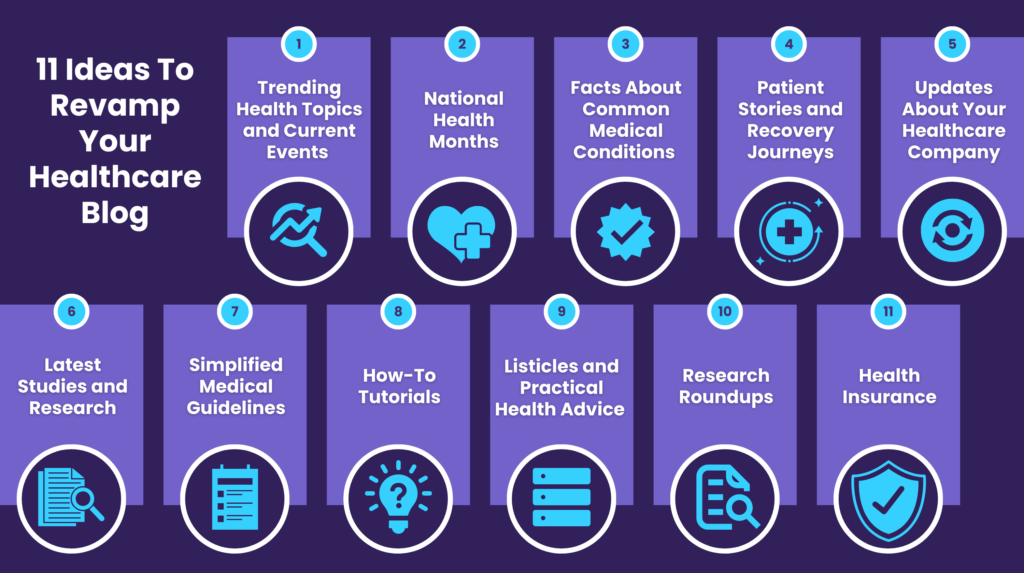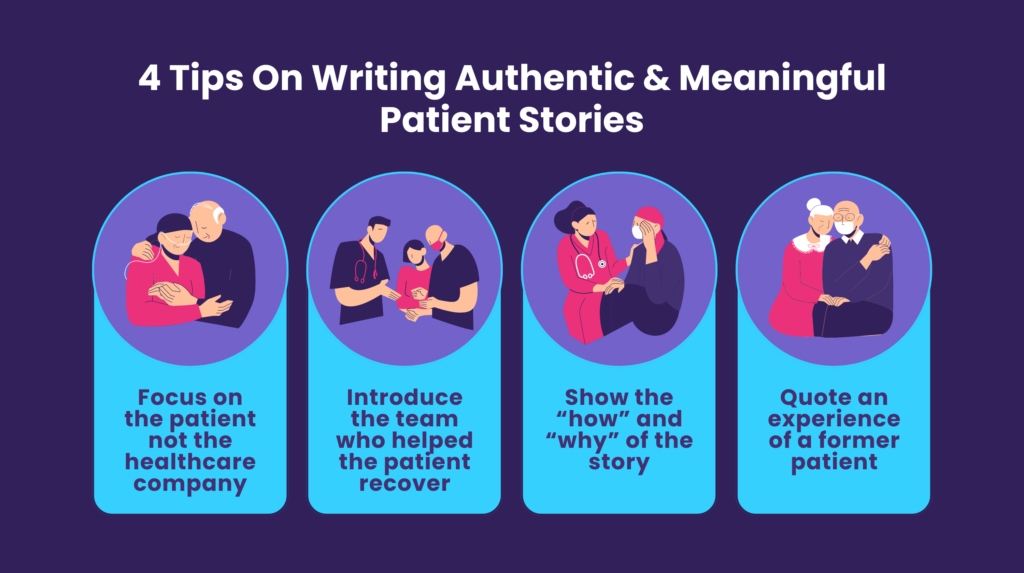Menu

The internet is a treasure trove of diverse information – including healthcare tips and medical questions which make up about 5% of the Google searches every year. Although it’s good to see that more people actively care about their health, they’re also prone to finding unreliable sources online that lead them to questionable and inaccurate information.
Healthcare companies face a lot of challenges when it comes to producing a functional and helpful blog. Aside from ensuring that each piece contains all the right information and latest findings, they should also come up with topics that pique the interest of readers and align with their overall brand.
So what kind of stories should readers find in a medical blog? Here are some ideas to help you start or revamp your healthcare blog:

Healthcare companies can benefit a lot from writing about the trending health topics and current events related to the industry. They can expect to experience a significant increase in their site traffic and engagement if they talk about the latest healthcare trends. It also allows them to raise awareness about the ongoing medical issues by publishing blog posts about the nature of the disease, its symptoms, and what people can do to avoid it.
But there are also a few things that healthcare practitioners must remember when writing about this kind of topic. One is that they should pay careful attention to the developing story and only write about the confirmed facts to avoid spreading misinformation.
Another reminder is that the topic they’re writing about should still be somehow related or aligned with their brand. Otherwise, the piece might only be hurtful to their overall content marketing strategy.
Lastly, most of these blog posts should be posted at the right time. It’s important to be one of the first blogs to publish content about the trending health topic or current event to gain as much traction as possible. But if you found out about the topic too late, make sure to post a fresh perspective or new information to avoid getting buried beneath all the other content.
Every month is a national health awareness month for different conditions – like May is Skin Cancer Awareness Month while October is Breast Cancer Awareness Month. These health campaigns aim to raise awareness and improve health across the country.
Health companies can take advantage of this and write content related to different health awareness campaigns that align with their brand. Just make sure to always check the latest NHO calendar online when planning a national health month content. To help you out, here are some of the major health campaigns that occur every month:
Everyone suffers from common health conditions like a sore throat, cough, or cold at some point in their lives. Some of us don’t think too much about it while others still look for remedies on the internet. Common medical conditions may also be a symptom of a more serious disease, healthcare professionals should still share information about them as they do for chronic health conditions.
Most healthcare blogs post facts about common medical conditions as long-form articles, but another option is to write them on an FAQ page. Take note of the questions that patients frequently ask about a specific medical condition. Compile all these questions and answer them concisely and accurately on your blog.
Great stories are one of the most powerful ways for healthcare providers to connect with their readers. When people hear about recovery journeys and patient stories, they may identify with the story and feel hope that they may also overcome their condition. Great stories also stimulate neural activities in the brain, making it easier for patients to remember what they read and everything associated with it – including your brand that told them about it.
But healthcare companies should be extra careful when writing about patient stories because certain patient information shouldn’t be shared with the public. To connect with audiences through patient stories, here are a few helpful tips that can help you write authentic and meaningful pieces:

Blogs are meant to educate audiences about different topics within the healthcare industry, but it’s also a good outlet to let the readers know what your healthcare company is about and what it’s been up to. Think of it as the brand’s own bulletin board – write about your medical exhibitions, milestones, and awards there for the audience to see.
Updates about the healthcare brand can pique the interest of some audiences who are looking for information about the treatment, service, or product you offer. It’s also a way to establish the company as an authority in the industry and a credible source of health and medical information.
There are always new developments in the medical industry that makes medicines and treatments more convenient and effective. New clinical evidence is also published every day to support different product claims and emphasize market limitations.
Many readers become interested whenever they hear about new information so they try to search for it on the internet. While studies published in medical journals are packed with all the relevant information they need about a topic, it might still be too difficult for them to read through dozens of pages filled with medical jargon and hard-to-understand data.
Blogging about the latest findings in the medical industry is a way for healthcare brands to relay important information to their audiences. They write it in layman’s terms so readers can still understand and retain the data they need.
Publishing this type of content also adds to the credibility of the brand as an authority and trusted source of information in its niche. It also shows the brand’s dedication to keeping up with the latest news and sharing it with its audiences.
Medical illiteracy among patients is high, so it’s not surprising that some of them might find health guidelines a bit too complicated to follow. Blogs about simplified medical guidelines can help patients understand and learn the ropes better, allowing them to know about the flow of treatments and why they matter.
Patients appreciate brands that try to make their lives easier. It’s also a bonus if medical blogs can publish these guidelines with an infographic or flow chart so they can reach more audiences. But be careful when writing about medical guidelines – they should be written in layman’s terms but brands should also make sure to retain the original thought when doing so.
Like when publishing the latest findings in the industry, posting simplified versions of health guidelines also helps boost brand credibility. It shows how much of an expert the practitioner is in the industry and how they’re willing to help more patients with their needs.
How-to guides are one of the most popular blog formats for healthcare companies because they’re plain and simple: find a problem then introduce a process to solve it. These tutorials are powerful content because they bring a lot of organic visits to the site from search engine results.
For example, writing about the steps to perform a self-examination for breast cancer might not gain immediate traction as healthcare trends do but it has a bigger impact on the brand in the long run. Every day, there are hundreds of people who look up this process on the internet so they’re likely to find your blog. Medical blog posts like this may even save lives.
But one thing to consider when making a how-to tutorial in a healthcare blog is to consider the validity of the content. These guides are important so you should only put instructions based on the latest findings and your area of expertise.
How-to articles work great for establishing the brand’s credibility and authority if they contain factual and accurate information – but they can also hurt the brand if they include flawed data.
Listicles have a particularly higher rate of engagement than some types of blog posts. There are plenty of things in the medical industry to write lists and long-form articles about, but patients always love reading about practical information and advice that they can implement immediately.
There are no set guidelines for creating a listicle for medical blogs, but they should always be concise and easy to read. Longer and more descriptive lists also have their own audiences but make sure that they’re always written with the most accurate information in mind.
Discoveries and developments happen in the medical industry every day – and they should always be reported regardless of how big or small their impact is on different people. To help readers keep up with the latest healthcare news, some medical blogs publish research roundups that list everything that happened in the health industry within the past week, month, or year.
While they both talk about the latest news in the medical industry, research roundups are actually different from writing about the latest trends. For one, blogging about the trending topics and latest findings focuses on a lot more details while research roundups are often written as lists and recaps.
When writing research roundups for the week or month, don’t forget to provide links and credit the sources properly so readers can check them out if they want to. Healthcare brands may also add their takes and commentaries to certain healthcare news if it’s related to their area of expertise.
A lot of confusion surrounds healthcare insurance coverage, which is why it’s one of the topics that most people look for online. Patients are always asking questions like “will my insurance cover this treatment?” or “what’s my copay?”
Although it may seem difficult to write about health insurance because each policy is different, healthcare blogs may still address some common questions and general information about insurance to attract the interest of readers. Medical companies may also explain which insurance policies cover which treatments in their facility through a blog post.
Establishing a well-performing medical blog is a lot like being a good healthcare practitioner – you need to listen to patients and meet their needs while trying to earn extra points for being empathic, thoughtful, and engaging. And if you need a patient-friendly blog that connects you to your audiences, Writrly is here to help with all your content needs and more.
With Writrly, there’s no need to deal with the headaches that come with hiring freelancers or thinking of new ideas to share in your medical blog. Our all-inclusive packages take everything from ideation to publication so you can focus on treating patients and serving them better.